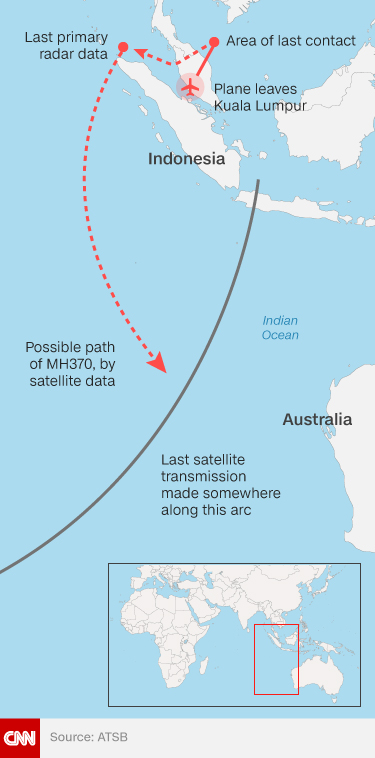

Authorities are meeting in Canberra, Australia, to examine evidence and potentially consider extending the undersea search zone.
"To have not found the aircraft at this stage is frustrating for everyone involved and particularly for the families of the passengers and crew," Australian Transport Minister Darren Chester said in a news conference on Wednesday.
Here's what we know so far.
The plane
At 12:41 a.m. on March 8, Malaysian Airlines Flight 370 departed Kuala Lumpur International Airport for Beijing.
From there, investigators believe it turned south around the edge of Indonesia and across the vast Indian Ocean.
But investigators still can't say what caused the crash.
Some theories include a loss of oxygen at altitude, which caused the pilot and passengers to lose consciousness, or a fire on board.
The passengers
Grandparents, a newly-graduated engineer, a young couple and a two-year-old boy were among 239 people on board MH370 when it vanished.
Individuals and families from 14 different countries were among those traveling to Beijing on that day, but mostly the crew and passengers were from China and Malaysia.
With no word of their loved ones in more than two years, relatives of the passengers have filed lawsuits against Malaysian Airlines.
The search
As of November 2016, more than 110,000 square kilometers (42,000 square miles) of sea floor had already been searched, without any sign of the plane.
The debris
Three pieces of the missing plane found off the coast of Africa have been confirmed as coming from MH370, using specific identification numbers.
The first piece found was a flaperon from the plane's wing, which was discovered on Reunion Island in July 2015, after which came two wing flaps which were discovered in Tanzania and Mauritius, in May and June 2016, respectively.
Six other pieces of wreckage found off the African coast, including Mozambique and South Africa, have been considered by the Australian Transport Safety Bureau as likely coming from the missing plane, although they haven't be confirmed.
In total, 20 piece of debris have been brought to the attention of the investigative team.
The ocean currents
"There it could join the South Equatorial current moving westwards until it joined the Mozambique current traveling along the African coast," he wrote.
But aside from that, O'Neill and Associates aviation expert Peter Goelz said the pieces discovered so far have told us very little about the disappearance of MH370.
"All it tells us is what we suspected, in that the plane crashed somewhere in the South Indian Ocean," he told CNN.
What happens now?
When the underwater investigation finishes, Goelz says the entire search will effectively be over, except for going over old evidence and findings.
"At some time in the future there will be a quantum leap forward in the ability to look underneath the sea and someone will find it. But that's not for decades," he said.
"I think at some point, they'll find it -- it's too big a mystery. But the technology we have now, we can't do it easily or cheaply."
The meeting in Canberra will involve Malaysian, Chinese and Australian officials who will discuss the search.
Even it's suspended, Australian and Malaysian officials have been emphatic that it doesn't mean they're giving up on the missing plane.






 Add Category
Add Category